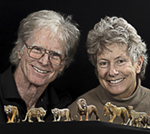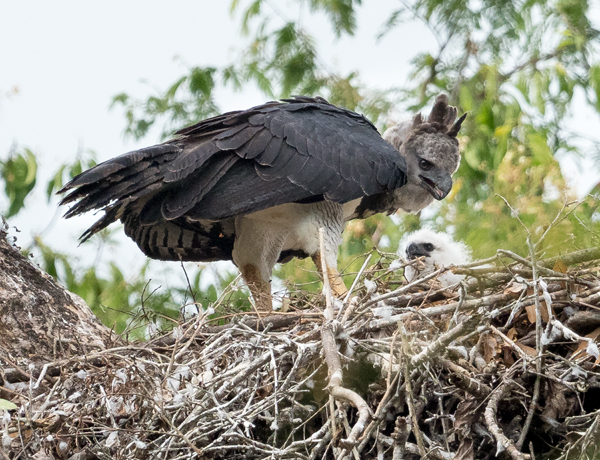
Harpy Eagle at nest, Darien Gap, Panama
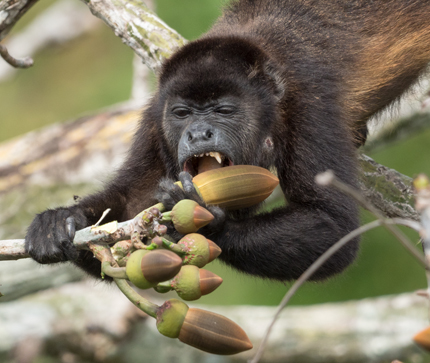
Howler Monkey, The Tower
PANAMA 2019
The Birds and Wildlife
SCOUTING TRIP REPORT
After our recent Costa Rica Hummingbird and Wildife Photo Tour, Mary and I headed to Panama for a Scouting Trip. While in Brazil's Pantanal, Mary had met the visionary owner/CEO of the Canopy Family, a Panama-based ecotourism company, who gratiously invited us to check out his various lodges. Our schedule was tight, but we did have twelve days free, after Costa Rica, to squeeze in a visit. For Mary and I, it was like a mini-vacation, as we were free of all our usual responsibilities, and we had a great visit.
Mary and I carried only Olympus camera (OMD-E Mark II) and equipment on this trip, which included a 300mm with 1.4X tele-converter, a 40-150mm with a 1.4X tele-converter, a 12-100 wide angle zoom, for the two of us, and a 60mm macro lens that was barely bigger than my thumb which we shared. Both of our kits fit inside one airline roll-on bag, and, in the field, I had three lenses mounted on three separate bodies, with the macro usually unattached as a spare, and one flash all inside my ThinkTank backpack. Since the micro 4/3rds system provides twice the magnification for any lens, my 300mm and 1.4X gave me a 840mm telephoto. The image stabilization of the lens and camera allowed me to hand-hold that rig, which I often did. Often, when Mary and I were walking trails, we mounted our telephotos on a RRS monopod, which provided all the support we needed for sharp images.
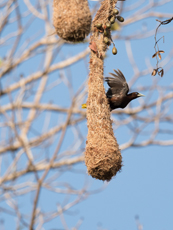
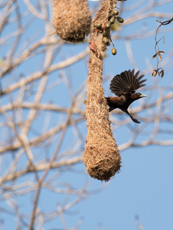
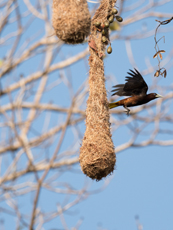
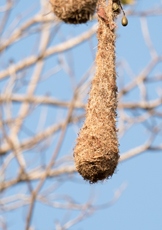
One of the features of the Olympus camera I'm using (OMD-E Mark II) is ProCapture, where 14 frames are recorded PRIOR to the shutter actually being fully depressed. With the camera shutter half-pressed, the camera records images in the buffer but doesn't write to the card. So long as the shutter is half-pressed the camera continually records, rewriting over the last frame in a continuous loop. I fired when this Crested Oropendula left its nest, and in my reaction time I only caught the nest, without a bird in the frame. However, via ProCapture I also recorded the 14 previous frames, which captured the bird in flight and while it still hung on the edge of the nest, the instant before launching. With ProCapture I'm capturing shots I've usually missed in the past.
We visited all three major lodges, starting at the very unique Canopy Tower, an ecolodge adapted from an old and deteriorating US Radio Tower facility on the top of a jungled hill in Serano National Park. The Tower is now redone as a great facility for observing and photographing wildlife, with the top level at, or above, the surrounding trees.
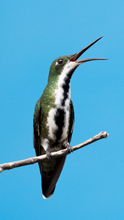
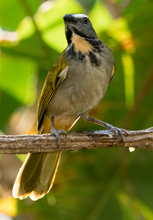
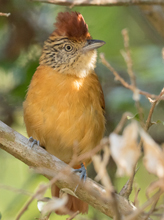
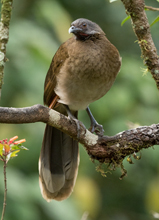
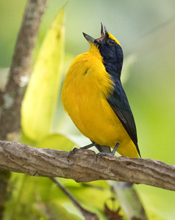
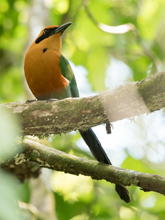
Black Mango; Buff-throated Saltator; Barred Antshrike; Gray-headed Chachalaca
Thick-billed Euphonia; Rufous Mot-mot
The Tower is composed of several floors - the roof surrounds the round, multi-faceted radar dome, which provides a 360 degree view of the forest -- as you circle the dome. One never knows what may show up at treetop level, and just after we left the Tower for our next destination a King Vulture perched on a bare tree right beside the tower! Earlier, before we arrived, an Ornate Hawk-Eagle (I think) did the same. We didn't have that type of luck, but I was hoping to photograph primates here, and we were very successful.
The naturalists/bird guides offered a field trip to a different destination each day, and Mary and I were faced with the delicious dilemna of choosing whether we did a field trip or stay around the Tower and photograph locally. On our first full day, several visitors went birding at the Pipeline, the most famous birding route in Panama. Birders saw well over 100 species of birds that day, while we ...
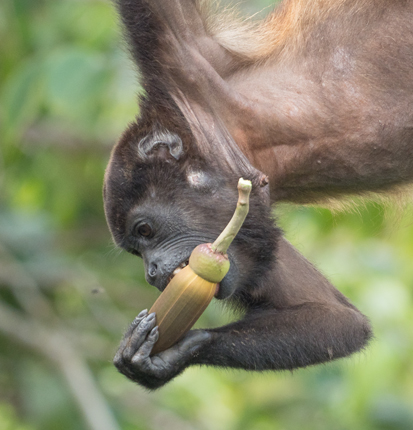
Well, we stayed behind, and worked on Howler Monkeys! A kapoc tree had dropped its leaves and was in flower, and on the day we arrived a family group had plucked nearly every fuzzy flower from the tree. A few flowers remained, and I was hopeful that the monkeys would return. One Howler returned, and plucked unopened flower pods, which it bit open, revealing the fuzzy, thread-like flower petals inside, and the sweet nectar, too. Shooting at treetop level, eye-level, we had the best shooting opportunity for Howler Monkeys we've ever had.
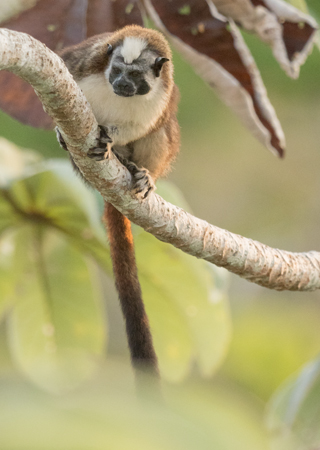
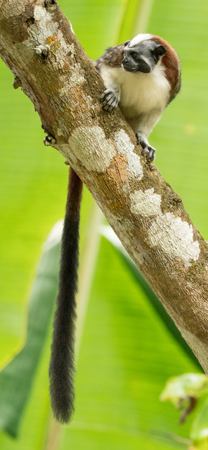
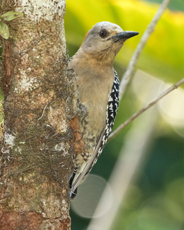
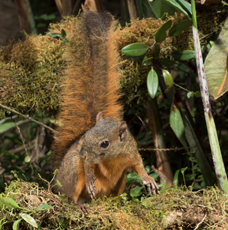
Geoffroy's Tamarin
Red-crownped Woodpecker; Red-tailed Squirrel
Geoffroy's Tamarins, a small primate that's midway between a squirrel and a small cat in size, visited the Tower's trees each day. This colorful, boldly patterned primate is native to Columbia and Panama, and we had several shooting opportunities while at the Tower.
On our second day at the Tower we joined birders on an all-day field trip where we visited multiple locations, including a US-expat's home that had extremely productive feeders. Rufous Mot-Mots, Bay-headed Tanagers, Snowy-bellied hummingbirds, and several other species visited the feeders frequently, making for an extremely productive afternoon.
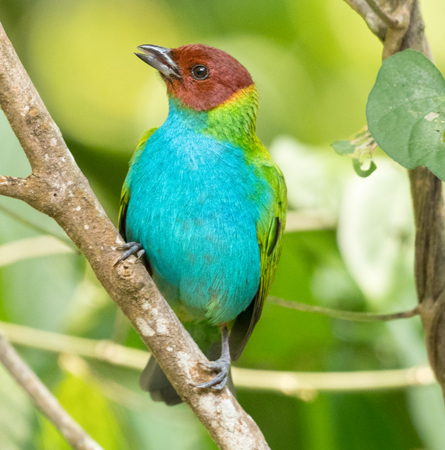
Bay-headed Tanager
I was hoping to see Owl Monkeys, the only noctural monkey in the New World, but we were unsuccessful. However, days after we left the Tower a guide found a den tree where two of these strikingly patterned monkeys peered out from a tree hollow. We were disappointed that we missed this unique primate, but I am encouraged that they're there ... for us to see next time!
Our next destination was the most remote, and one I've hoped to visit ever since my college days, when I visited Panama for the first and only times. The Darien is an almost mythic location, the territory that extends, roadless, east until it reaches trackless northern Columbia. A surprisingly good road snakes through the colonized section of the Darien, where our lodge was located, but that highway eventually stops, and nothing lies beyond. This is, obviously, the least settled area of Panama, and the home of the Harpy Eagle, the largest eagle in the Western Hemisphere and one of the largest eagles in the world. Seeing, and photographing, one was our hope and our goal.
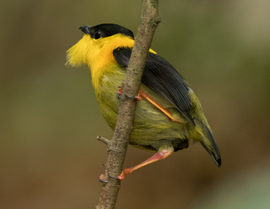
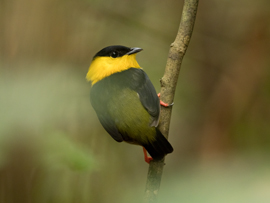
These Golden-collared Manakins were shot at ISOs of 1600, 2000, and 5000. The Harpy Eagle, seen elsewhere in this report, was shot at ISO 2000.
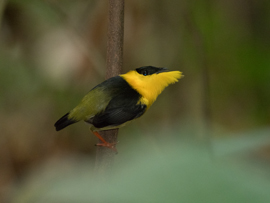 I explored the jungle on our first day here, where I spent nearly three quiet hours, alone and unhurried, with a lek of very noisy Golden-collared Manakins. When I entered the jungle I could hear the snaps and buzzes of Manakins, and I climbed uphill along the trail for a closer looks. The birds were hidden, but luckily I noticed a couple of patches of bare earth on the otherwise leaf-covered forest floor and, either from watching nature videos or from my reading, I recognized the patches as the sign of a breeding lek. I stopped, and waited, and five or ten minutes later the first birds returned, snapping their wings and trilling a buzzing note, then rapidly hopping back and forth from one low branch to another, to fast for me to focus a lens. More birds joined in, and eventually I had Manakins all around me, calling and, luckily, perching for longer periods, sometimes only a few yards away. It was one of the highlights of the trip.
I explored the jungle on our first day here, where I spent nearly three quiet hours, alone and unhurried, with a lek of very noisy Golden-collared Manakins. When I entered the jungle I could hear the snaps and buzzes of Manakins, and I climbed uphill along the trail for a closer looks. The birds were hidden, but luckily I noticed a couple of patches of bare earth on the otherwise leaf-covered forest floor and, either from watching nature videos or from my reading, I recognized the patches as the sign of a breeding lek. I stopped, and waited, and five or ten minutes later the first birds returned, snapping their wings and trilling a buzzing note, then rapidly hopping back and forth from one low branch to another, to fast for me to focus a lens. More birds joined in, and eventually I had Manakins all around me, calling and, luckily, perching for longer periods, sometimes only a few yards away. It was one of the highlights of the trip.
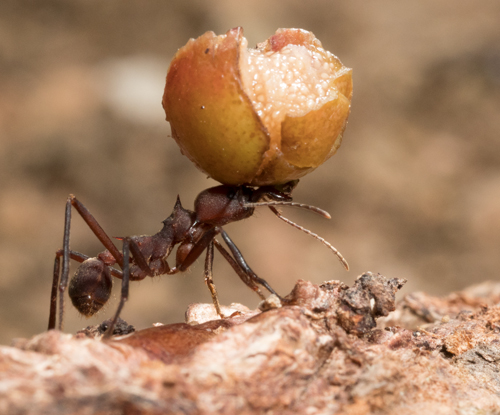
Leaf-cutter Ants harvested leaves and followed a trail to and from their nest that crossed the bottom step leading to our tent, and I spent a good part of a morning working the ants, and doing a video on how I set up Phottix flashes and Phottix Ares transmitters and receivers.
Because this was a scouting trip we only had limited time, just two full days at the tented lodge. Fortunately, a trip was planned for a Harpy Eagle expedition on our second day, an exciting journey that involved a 4AM breakfast, an hour plus drive to a boat launch, another hour in the predawn darkness by motorized canoe, a 45 minute 4x4 ride into the jungle, and a two mile hike. We arrived in the vicinity of the Harpy Eagle nest by 9AM, in a hilly forest, tall, sky-high trees blocking out the morning light. I didn't know what to expect, and when we arrived at the nest I missed it at first, as the nest seemed to meld into the fork of a large tree.
A four-month old Harpy Eagle chick hopped about on top, but by the time I got set up the chick was lying low and resting. Over the next two hours the chick rose periodically, and I fired probably 600 shots or more, all of which I later deleted.
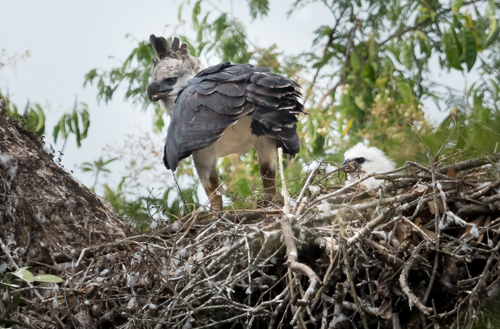
Harpy Eagle and chick, ISO 2000, shot with the 300mm and 1.4X tele-converter, for an effective focal length of 840mm. This image is cropped, and represents only about 1/4th of the actual image area. Nice detail!
We were hoping for some sign, that the chick would start calling or crying when, or if, it spotted an adult, but except for a bit of head bobbing and weaving, we had no warning when an adult swooped in, carrying a young Sloth. For the next hour or so the adult picked away at the carcass, passing small tidpits to the chick that fed surprisingly patiently. At the end of the meal the adult hopped up to the trunk above the nest, where it remained as we called it a morning and headed back to reverse the journey. We arrived back at our lodge at dusk -- a 14 hour day.
Our last stop was the Canopy Lodge, a beautiful facility and certainly the nicest lodge I've visited in Central America. Getting there, from the Darien, required most of a day, although we stopped at a restaurant mid-route where we had a lot of luck with Hummingbirds, including the beautiful Black Mango.
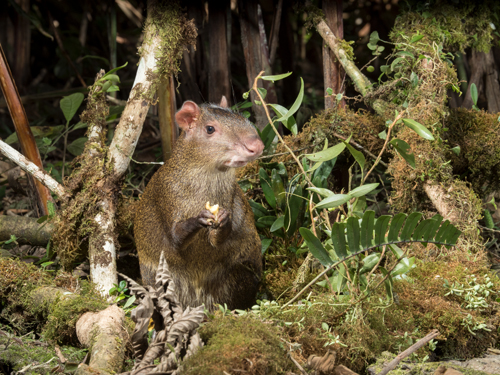
Agouti
There was an active bird feeder at the lodge, and Agoutis, a large rodent that reminds me of an African dwarf antelope -- think Dik-Dik. I set up a multiple flash system and spent much of my free time sitting in a shaded alcove in the surrounding trees, waiting for the Agoutis to find the alternate food source I'd placed nearby. Birds found it first, including Flame-rumped Tanagers and Clay-colored Thrushes, but eventually the Agoutis came in, too, and I shot the best images I've ever made of this forest creature.
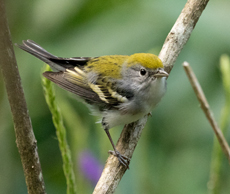
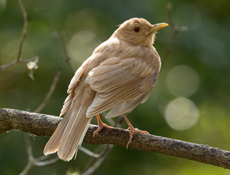
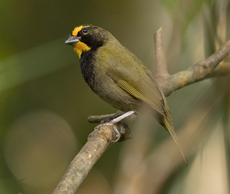
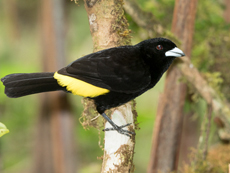
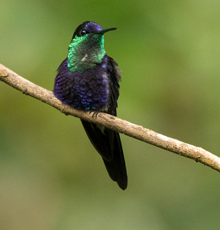
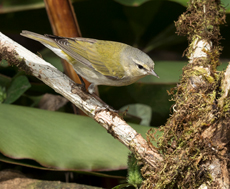
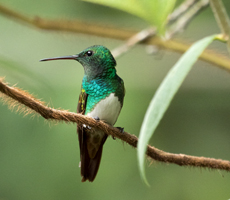
Bay-breasted Warbler; Clay-colored Thrush
Yellow-faced Grassquit; Flame-rumped Tanager; Violet-crowned Woodnymph
Tennesse Warbler; Snowy-bellied hummingbird
On an afternoon birding trip I was taken to a roosting location for Central and South America's most striking owl, the Spectacled Owl, where we had three sitting at the edge of a woodlot in full view. Several new species of birds provided fleeting chances for shots, including a very good session with a female Barred Antshrike.
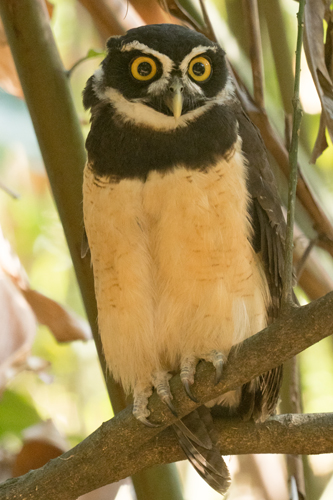
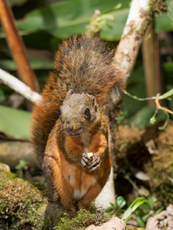
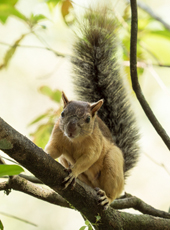
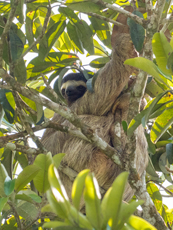
Red-tailed and Variegated Squirrels; Three-toed Sloth
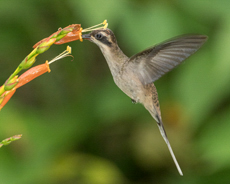
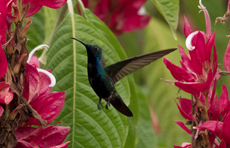
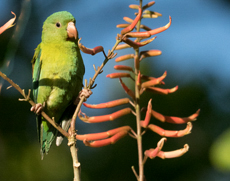
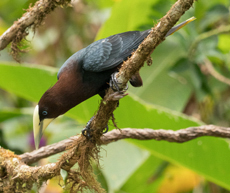

Long-billed Hermit; Black Mango
Orange-chinned Parakeet; Crested Oropendola x 2
We didn't keep an active bird list, as we didn't 'count' birds that were barely dark silhouettes on trees or limbs, but even so, we did record over 100 species that met our standards, and birders at the lodges were typically recording 200 'life birds' at two or three of the lodges.
Our time in Panama went too quickly, and although some of the birds were similar to those we saw in Costa Rica, we added a lot of new species to our tropical portfolio. Our highlight, perhaps, was the Harpy Eagle, but visiting the Darien and enjoying the jungle, the birds, and the wildlife at three different locations in the Canopy Camp family was simply precious. We can't wait to return.
Why you should travel with us
Testimonials
Join us on Facebook at: Follow Hoot Hollow
Office Phone: (717) 543-6423
Or FAX us at: (717) 543-5342
Mary and Joe are proud to endorse the Photo Retailer that has
done the absolute most in supporting nature photography in all
its facets ---

Check out the Monthly Specials
from Hunt's
Check out these TPPA specials!

Harpy Eagle at nest, Darien Gap, Panama

Howler Monkey, The Tower
PANAMA 2019
The Birds and Wildlife
SCOUTING TRIP REPORT
After our recent Costa Rica Hummingbird and Wildife Photo Tour, Mary and I headed to Panama for a Scouting Trip. While in Brazil's Pantanal, Mary had met the visionary owner/CEO of the Canopy Family, a Panama-based ecotourism company, who gratiously invited us to check out his various lodges. Our schedule was tight, but we did have twelve days free, after Costa Rica, to squeeze in a visit. For Mary and I, it was like a mini-vacation, as we were free of all our usual responsibilities, and we had a great visit.
Mary and I carried only Olympus camera (OMD-E Mark II) and equipment on this trip, which included a 300mm with 1.4X tele-converter, a 40-150mm with a 1.4X tele-converter, a 12-100 wide angle zoom, for the two of us, and a 60mm macro lens that was barely bigger than my thumb which we shared. Both of our kits fit inside one airline roll-on bag, and, in the field, I had three lenses mounted on three separate bodies, with the macro usually unattached as a spare, and one flash all inside my ThinkTank backpack. Since the micro 4/3rds system provides twice the magnification for any lens, my 300mm and 1.4X gave me a 840mm telephoto. The image stabilization of the lens and camera allowed me to hand-hold that rig, which I often did. Often, when Mary and I were walking trails, we mounted our telephotos on a RRS monopod, which provided all the support we needed for sharp images.




One of the features of the Olympus camera I'm using (OMD-E Mark II) is ProCapture, where 14 frames are recorded PRIOR to the shutter actually being fully depressed. With the camera shutter half-pressed, the camera records images in the buffer but doesn't write to the card. So long as the shutter is half-pressed the camera continually records, rewriting over the last frame in a continuous loop. I fired when this Crested Oropendula left its nest, and in my reaction time I only caught the nest, without a bird in the frame. However, via ProCapture I also recorded the 14 previous frames, which captured the bird in flight and while it still hung on the edge of the nest, the instant before launching. With ProCapture I'm capturing shots I've usually missed in the past.
We visited all three major lodges, starting at the very unique Canopy Tower, an ecolodge adapted from an old and deteriorating US Radio Tower facility on the top of a jungled hill in Serano National Park. The Tower is now redone as a great facility for observing and photographing wildlife, with the top level at, or above, the surrounding trees.






Black Mango; Buff-throated Saltator; Barred Antshrike; Gray-headed Chachalaca
Thick-billed Euphonia; Rufous Mot-mot
The Tower is composed of several floors - the roof surrounds the round, multi-faceted radar dome, which provides a 360 degree view of the forest -- as you circle the dome. One never knows what may show up at treetop level, and just after we left the Tower for our next destination a King Vulture perched on a bare tree right beside the tower! Earlier, before we arrived, an Ornate Hawk-Eagle (I think) did the same. We didn't have that type of luck, but I was hoping to photograph primates here, and we were very successful.
The naturalists/bird guides offered a field trip to a different destination each day, and Mary and I were faced with the delicious dilemna of choosing whether we did a field trip or stay around the Tower and photograph locally. On our first full day, several visitors went birding at the Pipeline, the most famous birding route in Panama. Birders saw well over 100 species of birds that day, while we ...

Well, we stayed behind, and worked on Howler Monkeys! A kapoc tree had dropped its leaves and was in flower, and on the day we arrived a family group had plucked nearly every fuzzy flower from the tree. A few flowers remained, and I was hopeful that the monkeys would return. One Howler returned, and plucked unopened flower pods, which it bit open, revealing the fuzzy, thread-like flower petals inside, and the sweet nectar, too. Shooting at treetop level, eye-level, we had the best shooting opportunity for Howler Monkeys we've ever had.




Geoffroy's Tamarin
Red-crownped Woodpecker; Red-tailed Squirrel
Geoffroy's Tamarins, a small primate that's midway between a squirrel and a small cat in size, visited the Tower's trees each day. This colorful, boldly patterned primate is native to Columbia and Panama, and we had several shooting opportunities while at the Tower.
On our second day at the Tower we joined birders on an all-day field trip where we visited multiple locations, including a US-expat's home that had extremely productive feeders. Rufous Mot-Mots, Bay-headed Tanagers, Snowy-bellied hummingbirds, and several other species visited the feeders frequently, making for an extremely productive afternoon.

Bay-headed Tanager
I was hoping to see Owl Monkeys, the only noctural monkey in the New World, but we were unsuccessful. However, days after we left the Tower a guide found a den tree where two of these strikingly patterned monkeys peered out from a tree hollow. We were disappointed that we missed this unique primate, but I am encouraged that they're there ... for us to see next time!
Our next destination was the most remote, and one I've hoped to visit ever since my college days, when I visited Panama for the first and only times. The Darien is an almost mythic location, the territory that extends, roadless, east until it reaches trackless northern Columbia. A surprisingly good road snakes through the colonized section of the Darien, where our lodge was located, but that highway eventually stops, and nothing lies beyond. This is, obviously, the least settled area of Panama, and the home of the Harpy Eagle, the largest eagle in the Western Hemisphere and one of the largest eagles in the world. Seeing, and photographing, one was our hope and our goal.


These Golden-collared Manakins were shot at ISOs of 1600, 2000, and 5000. The Harpy Eagle, seen elsewhere in this report, was shot at ISO 2000.
 I explored the jungle on our first day here, where I spent nearly three quiet hours, alone and unhurried, with a lek of very noisy Golden-collared Manakins. When I entered the jungle I could hear the snaps and buzzes of Manakins, and I climbed uphill along the trail for a closer looks. The birds were hidden, but luckily I noticed a couple of patches of bare earth on the otherwise leaf-covered forest floor and, either from watching nature videos or from my reading, I recognized the patches as the sign of a breeding lek. I stopped, and waited, and five or ten minutes later the first birds returned, snapping their wings and trilling a buzzing note, then rapidly hopping back and forth from one low branch to another, to fast for me to focus a lens. More birds joined in, and eventually I had Manakins all around me, calling and, luckily, perching for longer periods, sometimes only a few yards away. It was one of the highlights of the trip.
I explored the jungle on our first day here, where I spent nearly three quiet hours, alone and unhurried, with a lek of very noisy Golden-collared Manakins. When I entered the jungle I could hear the snaps and buzzes of Manakins, and I climbed uphill along the trail for a closer looks. The birds were hidden, but luckily I noticed a couple of patches of bare earth on the otherwise leaf-covered forest floor and, either from watching nature videos or from my reading, I recognized the patches as the sign of a breeding lek. I stopped, and waited, and five or ten minutes later the first birds returned, snapping their wings and trilling a buzzing note, then rapidly hopping back and forth from one low branch to another, to fast for me to focus a lens. More birds joined in, and eventually I had Manakins all around me, calling and, luckily, perching for longer periods, sometimes only a few yards away. It was one of the highlights of the trip.

Leaf-cutter Ants harvested leaves and followed a trail to and from their nest that crossed the bottom step leading to our tent, and I spent a good part of a morning working the ants, and doing a video on how I set up Phottix flashes and Phottix Ares transmitters and receivers.
Because this was a scouting trip we only had limited time, just two full days at the tented lodge. Fortunately, a trip was planned for a Harpy Eagle expedition on our second day, an exciting journey that involved a 4AM breakfast, an hour plus drive to a boat launch, another hour in the predawn darkness by motorized canoe, a 45 minute 4x4 ride into the jungle, and a two mile hike. We arrived in the vicinity of the Harpy Eagle nest by 9AM, in a hilly forest, tall, sky-high trees blocking out the morning light. I didn't know what to expect, and when we arrived at the nest I missed it at first, as the nest seemed to meld into the fork of a large tree.
A four-month old Harpy Eagle chick hopped about on top, but by the time I got set up the chick was lying low and resting. Over the next two hours the chick rose periodically, and I fired probably 600 shots or more, all of which I later deleted.

Harpy Eagle and chick, ISO 2000, shot with the 300mm and 1.4X tele-converter, for an effective focal length of 840mm. This image is cropped, and represents only about 1/4th of the actual image area. Nice detail!
We were hoping for some sign, that the chick would start calling or crying when, or if, it spotted an adult, but except for a bit of head bobbing and weaving, we had no warning when an adult swooped in, carrying a young Sloth. For the next hour or so the adult picked away at the carcass, passing small tidpits to the chick that fed surprisingly patiently. At the end of the meal the adult hopped up to the trunk above the nest, where it remained as we called it a morning and headed back to reverse the journey. We arrived back at our lodge at dusk -- a 14 hour day.
Our last stop was the Canopy Lodge, a beautiful facility and certainly the nicest lodge I've visited in Central America. Getting there, from the Darien, required most of a day, although we stopped at a restaurant mid-route where we had a lot of luck with Hummingbirds, including the beautiful Black Mango.

Agouti
There was an active bird feeder at the lodge, and Agoutis, a large rodent that reminds me of an African dwarf antelope -- think Dik-Dik. I set up a multiple flash system and spent much of my free time sitting in a shaded alcove in the surrounding trees, waiting for the Agoutis to find the alternate food source I'd placed nearby. Birds found it first, including Flame-rumped Tanagers and Clay-colored Thrushes, but eventually the Agoutis came in, too, and I shot the best images I've ever made of this forest creature.







Bay-breasted Warbler; Clay-colored Thrush
Yellow-faced Grassquit; Flame-rumped Tanager; Violet-crowned Woodnymph
Tennesse Warbler; Snowy-bellied hummingbird
On an afternoon birding trip I was taken to a roosting location for Central and South America's most striking owl, the Spectacled Owl, where we had three sitting at the edge of a woodlot in full view. Several new species of birds provided fleeting chances for shots, including a very good session with a female Barred Antshrike.




Red-tailed and Variegated Squirrels; Three-toed Sloth





Long-billed Hermit; Black Mango
Orange-chinned Parakeet; Crested Oropendola x 2
We didn't keep an active bird list, as we didn't 'count' birds that were barely dark silhouettes on trees or limbs, but even so, we did record over 100 species that met our standards, and birders at the lodges were typically recording 200 'life birds' at two or three of the lodges.
Our time in Panama went too quickly, and although some of the birds were similar to those we saw in Costa Rica, we added a lot of new species to our tropical portfolio. Our highlight, perhaps, was the Harpy Eagle, but visiting the Darien and enjoying the jungle, the birds, and the wildlife at three different locations in the Canopy Camp family was simply precious. We can't wait to return.
Why you should travel with us
Testimonials
Join us on Facebook at: Follow Hoot Hollow
Office Phone: (717) 543-6423
Or FAX us at: (717) 543-5342
Mary and Joe are proud to endorse the Photo Retailer that has
done the absolute most in supporting nature photography in all
its facets ---

Check out the Monthly Specials
from Hunt's
Check out these TPPA specials!

Harpy Eagle at nest, Darien Gap, Panama

Howler Monkey, The Tower
PANAMA 2019
The Birds and Wildlife
SCOUTING TRIP REPORT
After our recent Costa Rica Hummingbird and Wildife Photo Tour, Mary and I headed to Panama for a Scouting Trip. While in Brazil's Pantanal, Mary had met the visionary owner/CEO of the Canopy Family, a Panama-based ecotourism company, who gratiously invited us to check out his various lodges. Our schedule was tight, but we did have twelve days free, after Costa Rica, to squeeze in a visit. For Mary and I, it was like a mini-vacation, as we were free of all our usual responsibilities, and we had a great visit.
Mary and I carried only Olympus camera (OMD-E Mark II) and equipment on this trip, which included a 300mm with 1.4X tele-converter, a 40-150mm with a 1.4X tele-converter, a 12-100 wide angle zoom, for the two of us, and a 60mm macro lens that was barely bigger than my thumb which we shared. Both of our kits fit inside one airline roll-on bag, and, in the field, I had three lenses mounted on three separate bodies, with the macro usually unattached as a spare, and one flash all inside my ThinkTank backpack. Since the micro 4/3rds system provides twice the magnification for any lens, my 300mm and 1.4X gave me a 840mm telephoto. The image stabilization of the lens and camera allowed me to hand-hold that rig, which I often did. Often, when Mary and I were walking trails, we mounted our telephotos on a RRS monopod, which provided all the support we needed for sharp images.




One of the features of the Olympus camera I'm using (OMD-E Mark II) is ProCapture, where 14 frames are recorded PRIOR to the shutter actually being fully depressed. With the camera shutter half-pressed, the camera records images in the buffer but doesn't write to the card. So long as the shutter is half-pressed the camera continually records, rewriting over the last frame in a continuous loop. I fired when this Crested Oropendula left its nest, and in my reaction time I only caught the nest, without a bird in the frame. However, via ProCapture I also recorded the 14 previous frames, which captured the bird in flight and while it still hung on the edge of the nest, the instant before launching. With ProCapture I'm capturing shots I've usually missed in the past.
We visited all three major lodges, starting at the very unique Canopy Tower, an ecolodge adapted from an old and deteriorating US Radio Tower facility on the top of a jungled hill in Serano National Park. The Tower is now redone as a great facility for observing and photographing wildlife, with the top level at, or above, the surrounding trees.






Black Mango; Buff-throated Saltator; Barred Antshrike; Gray-headed Chachalaca
Thick-billed Euphonia; Rufous Mot-mot
The Tower is composed of several floors - the roof surrounds the round, multi-faceted radar dome, which provides a 360 degree view of the forest -- as you circle the dome. One never knows what may show up at treetop level, and just after we left the Tower for our next destination a King Vulture perched on a bare tree right beside the tower! Earlier, before we arrived, an Ornate Hawk-Eagle (I think) did the same. We didn't have that type of luck, but I was hoping to photograph primates here, and we were very successful.
The naturalists/bird guides offered a field trip to a different destination each day, and Mary and I were faced with the delicious dilemna of choosing whether we did a field trip or stay around the Tower and photograph locally. On our first full day, several visitors went birding at the Pipeline, the most famous birding route in Panama. Birders saw well over 100 species of birds that day, while we ...

Well, we stayed behind, and worked on Howler Monkeys! A kapoc tree had dropped its leaves and was in flower, and on the day we arrived a family group had plucked nearly every fuzzy flower from the tree. A few flowers remained, and I was hopeful that the monkeys would return. One Howler returned, and plucked unopened flower pods, which it bit open, revealing the fuzzy, thread-like flower petals inside, and the sweet nectar, too. Shooting at treetop level, eye-level, we had the best shooting opportunity for Howler Monkeys we've ever had.




Geoffroy's Tamarin
Red-crownped Woodpecker; Red-tailed Squirrel
Geoffroy's Tamarins, a small primate that's midway between a squirrel and a small cat in size, visited the Tower's trees each day. This colorful, boldly patterned primate is native to Columbia and Panama, and we had several shooting opportunities while at the Tower.
On our second day at the Tower we joined birders on an all-day field trip where we visited multiple locations, including a US-expat's home that had extremely productive feeders. Rufous Mot-Mots, Bay-headed Tanagers, Snowy-bellied hummingbirds, and several other species visited the feeders frequently, making for an extremely productive afternoon.

Bay-headed Tanager
I was hoping to see Owl Monkeys, the only noctural monkey in the New World, but we were unsuccessful. However, days after we left the Tower a guide found a den tree where two of these strikingly patterned monkeys peered out from a tree hollow. We were disappointed that we missed this unique primate, but I am encouraged that they're there ... for us to see next time!
Our next destination was the most remote, and one I've hoped to visit ever since my college days, when I visited Panama for the first and only times. The Darien is an almost mythic location, the territory that extends, roadless, east until it reaches trackless northern Columbia. A surprisingly good road snakes through the colonized section of the Darien, where our lodge was located, but that highway eventually stops, and nothing lies beyond. This is, obviously, the least settled area of Panama, and the home of the Harpy Eagle, the largest eagle in the Western Hemisphere and one of the largest eagles in the world. Seeing, and photographing, one was our hope and our goal.


These Golden-collared Manakins were shot at ISOs of 1600, 2000, and 5000. The Harpy Eagle, seen elsewhere in this report, was shot at ISO 2000.
 I explored the jungle on our first day here, where I spent nearly three quiet hours, alone and unhurried, with a lek of very noisy Golden-collared Manakins. When I entered the jungle I could hear the snaps and buzzes of Manakins, and I climbed uphill along the trail for a closer looks. The birds were hidden, but luckily I noticed a couple of patches of bare earth on the otherwise leaf-covered forest floor and, either from watching nature videos or from my reading, I recognized the patches as the sign of a breeding lek. I stopped, and waited, and five or ten minutes later the first birds returned, snapping their wings and trilling a buzzing note, then rapidly hopping back and forth from one low branch to another, to fast for me to focus a lens. More birds joined in, and eventually I had Manakins all around me, calling and, luckily, perching for longer periods, sometimes only a few yards away. It was one of the highlights of the trip.
I explored the jungle on our first day here, where I spent nearly three quiet hours, alone and unhurried, with a lek of very noisy Golden-collared Manakins. When I entered the jungle I could hear the snaps and buzzes of Manakins, and I climbed uphill along the trail for a closer looks. The birds were hidden, but luckily I noticed a couple of patches of bare earth on the otherwise leaf-covered forest floor and, either from watching nature videos or from my reading, I recognized the patches as the sign of a breeding lek. I stopped, and waited, and five or ten minutes later the first birds returned, snapping their wings and trilling a buzzing note, then rapidly hopping back and forth from one low branch to another, to fast for me to focus a lens. More birds joined in, and eventually I had Manakins all around me, calling and, luckily, perching for longer periods, sometimes only a few yards away. It was one of the highlights of the trip.

Leaf-cutter Ants harvested leaves and followed a trail to and from their nest that crossed the bottom step leading to our tent, and I spent a good part of a morning working the ants, and doing a video on how I set up Phottix flashes and Phottix Ares transmitters and receivers.
Because this was a scouting trip we only had limited time, just two full days at the tented lodge. Fortunately, a trip was planned for a Harpy Eagle expedition on our second day, an exciting journey that involved a 4AM breakfast, an hour plus drive to a boat launch, another hour in the predawn darkness by motorized canoe, a 45 minute 4x4 ride into the jungle, and a two mile hike. We arrived in the vicinity of the Harpy Eagle nest by 9AM, in a hilly forest, tall, sky-high trees blocking out the morning light. I didn't know what to expect, and when we arrived at the nest I missed it at first, as the nest seemed to meld into the fork of a large tree.
A four-month old Harpy Eagle chick hopped about on top, but by the time I got set up the chick was lying low and resting. Over the next two hours the chick rose periodically, and I fired probably 600 shots or more, all of which I later deleted.

Harpy Eagle and chick, ISO 2000, shot with the 300mm and 1.4X tele-converter, for an effective focal length of 840mm. This image is cropped, and represents only about 1/4th of the actual image area. Nice detail!
We were hoping for some sign, that the chick would start calling or crying when, or if, it spotted an adult, but except for a bit of head bobbing and weaving, we had no warning when an adult swooped in, carrying a young Sloth. For the next hour or so the adult picked away at the carcass, passing small tidpits to the chick that fed surprisingly patiently. At the end of the meal the adult hopped up to the trunk above the nest, where it remained as we called it a morning and headed back to reverse the journey. We arrived back at our lodge at dusk -- a 14 hour day.
Our last stop was the Canopy Lodge, a beautiful facility and certainly the nicest lodge I've visited in Central America. Getting there, from the Darien, required most of a day, although we stopped at a restaurant mid-route where we had a lot of luck with Hummingbirds, including the beautiful Black Mango.

Agouti
There was an active bird feeder at the lodge, and Agoutis, a large rodent that reminds me of an African dwarf antelope -- think Dik-Dik. I set up a multiple flash system and spent much of my free time sitting in a shaded alcove in the surrounding trees, waiting for the Agoutis to find the alternate food source I'd placed nearby. Birds found it first, including Flame-rumped Tanagers and Clay-colored Thrushes, but eventually the Agoutis came in, too, and I shot the best images I've ever made of this forest creature.







Bay-breasted Warbler; Clay-colored Thrush
Yellow-faced Grassquit; Flame-rumped Tanager; Violet-crowned Woodnymph
Tennesse Warbler; Snowy-bellied hummingbird
On an afternoon birding trip I was taken to a roosting location for Central and South America's most striking owl, the Spectacled Owl, where we had three sitting at the edge of a woodlot in full view. Several new species of birds provided fleeting chances for shots, including a very good session with a female Barred Antshrike.




Red-tailed and Variegated Squirrels; Three-toed Sloth





Long-billed Hermit; Black Mango
Orange-chinned Parakeet; Crested Oropendola x 2
We didn't keep an active bird list, as we didn't 'count' birds that were barely dark silhouettes on trees or limbs, but even so, we did record over 100 species that met our standards, and birders at the lodges were typically recording 200 'life birds' at two or three of the lodges.
Our time in Panama went too quickly, and although some of the birds were similar to those we saw in Costa Rica, we added a lot of new species to our tropical portfolio. Our highlight, perhaps, was the Harpy Eagle, but visiting the Darien and enjoying the jungle, the birds, and the wildlife at three different locations in the Canopy Camp family was simply precious. We can't wait to return.
Why you should travel with us
Testimonials
Join us on Facebook at: Follow Hoot Hollow
Office Phone: (717) 543-6423
Or FAX us at: (717) 543-5342
Mary and Joe are proud to endorse the Photo Retailer that has
done the absolute most in supporting nature photography in all
its facets ---

Check out the Monthly Specials
from Hunt's
Check out these TPPA specials!

Harpy Eagle at nest, Darien Gap, Panama

Howler Monkey, The Tower
PANAMA 2019
The Birds and Wildlife
SCOUTING TRIP REPORT
After our recent Costa Rica Hummingbird and Wildife Photo Tour, Mary and I headed to Panama for a Scouting Trip. While in Brazil's Pantanal, Mary had met the visionary owner/CEO of the Canopy Family, a Panama-based ecotourism company, who gratiously invited us to check out his various lodges. Our schedule was tight, but we did have twelve days free, after Costa Rica, to squeeze in a visit. For Mary and I, it was like a mini-vacation, as we were free of all our usual responsibilities, and we had a great visit.
Mary and I carried only Olympus camera (OMD-E Mark II) and equipment on this trip, which included a 300mm with 1.4X tele-converter, a 40-150mm with a 1.4X tele-converter, a 12-100 wide angle zoom, for the two of us, and a 60mm macro lens that was barely bigger than my thumb which we shared. Both of our kits fit inside one airline roll-on bag, and, in the field, I had three lenses mounted on three separate bodies, with the macro usually unattached as a spare, and one flash all inside my ThinkTank backpack. Since the micro 4/3rds system provides twice the magnification for any lens, my 300mm and 1.4X gave me a 840mm telephoto. The image stabilization of the lens and camera allowed me to hand-hold that rig, which I often did. Often, when Mary and I were walking trails, we mounted our telephotos on a RRS monopod, which provided all the support we needed for sharp images.




One of the features of the Olympus camera I'm using (OMD-E Mark II) is ProCapture, where 14 frames are recorded PRIOR to the shutter actually being fully depressed. With the camera shutter half-pressed, the camera records images in the buffer but doesn't write to the card. So long as the shutter is half-pressed the camera continually records, rewriting over the last frame in a continuous loop. I fired when this Crested Oropendula left its nest, and in my reaction time I only caught the nest, without a bird in the frame. However, via ProCapture I also recorded the 14 previous frames, which captured the bird in flight and while it still hung on the edge of the nest, the instant before launching. With ProCapture I'm capturing shots I've usually missed in the past.
We visited all three major lodges, starting at the very unique Canopy Tower, an ecolodge adapted from an old and deteriorating US Radio Tower facility on the top of a jungled hill in Serano National Park. The Tower is now redone as a great facility for observing and photographing wildlife, with the top level at, or above, the surrounding trees.






Black Mango; Buff-throated Saltator; Barred Antshrike; Gray-headed Chachalaca
Thick-billed Euphonia; Rufous Mot-mot
The Tower is composed of several floors - the roof surrounds the round, multi-faceted radar dome, which provides a 360 degree view of the forest -- as you circle the dome. One never knows what may show up at treetop level, and just after we left the Tower for our next destination a King Vulture perched on a bare tree right beside the tower! Earlier, before we arrived, an Ornate Hawk-Eagle (I think) did the same. We didn't have that type of luck, but I was hoping to photograph primates here, and we were very successful.
The naturalists/bird guides offered a field trip to a different destination each day, and Mary and I were faced with the delicious dilemna of choosing whether we did a field trip or stay around the Tower and photograph locally. On our first full day, several visitors went birding at the Pipeline, the most famous birding route in Panama. Birders saw well over 100 species of birds that day, while we ...

Well, we stayed behind, and worked on Howler Monkeys! A kapoc tree had dropped its leaves and was in flower, and on the day we arrived a family group had plucked nearly every fuzzy flower from the tree. A few flowers remained, and I was hopeful that the monkeys would return. One Howler returned, and plucked unopened flower pods, which it bit open, revealing the fuzzy, thread-like flower petals inside, and the sweet nectar, too. Shooting at treetop level, eye-level, we had the best shooting opportunity for Howler Monkeys we've ever had.




Geoffroy's Tamarin
Red-crownped Woodpecker; Red-tailed Squirrel
Geoffroy's Tamarins, a small primate that's midway between a squirrel and a small cat in size, visited the Tower's trees each day. This colorful, boldly patterned primate is native to Columbia and Panama, and we had several shooting opportunities while at the Tower.
On our second day at the Tower we joined birders on an all-day field trip where we visited multiple locations, including a US-expat's home that had extremely productive feeders. Rufous Mot-Mots, Bay-headed Tanagers, Snowy-bellied hummingbirds, and several other species visited the feeders frequently, making for an extremely productive afternoon.

Bay-headed Tanager
I was hoping to see Owl Monkeys, the only noctural monkey in the New World, but we were unsuccessful. However, days after we left the Tower a guide found a den tree where two of these strikingly patterned monkeys peered out from a tree hollow. We were disappointed that we missed this unique primate, but I am encouraged that they're there ... for us to see next time!
Our next destination was the most remote, and one I've hoped to visit ever since my college days, when I visited Panama for the first and only times. The Darien is an almost mythic location, the territory that extends, roadless, east until it reaches trackless northern Columbia. A surprisingly good road snakes through the colonized section of the Darien, where our lodge was located, but that highway eventually stops, and nothing lies beyond. This is, obviously, the least settled area of Panama, and the home of the Harpy Eagle, the largest eagle in the Western Hemisphere and one of the largest eagles in the world. Seeing, and photographing, one was our hope and our goal.


These Golden-collared Manakins were shot at ISOs of 1600, 2000, and 5000. The Harpy Eagle, seen elsewhere in this report, was shot at ISO 2000.
 I explored the jungle on our first day here, where I spent nearly three quiet hours, alone and unhurried, with a lek of very noisy Golden-collared Manakins. When I entered the jungle I could hear the snaps and buzzes of Manakins, and I climbed uphill along the trail for a closer looks. The birds were hidden, but luckily I noticed a couple of patches of bare earth on the otherwise leaf-covered forest floor and, either from watching nature videos or from my reading, I recognized the patches as the sign of a breeding lek. I stopped, and waited, and five or ten minutes later the first birds returned, snapping their wings and trilling a buzzing note, then rapidly hopping back and forth from one low branch to another, to fast for me to focus a lens. More birds joined in, and eventually I had Manakins all around me, calling and, luckily, perching for longer periods, sometimes only a few yards away. It was one of the highlights of the trip.
I explored the jungle on our first day here, where I spent nearly three quiet hours, alone and unhurried, with a lek of very noisy Golden-collared Manakins. When I entered the jungle I could hear the snaps and buzzes of Manakins, and I climbed uphill along the trail for a closer looks. The birds were hidden, but luckily I noticed a couple of patches of bare earth on the otherwise leaf-covered forest floor and, either from watching nature videos or from my reading, I recognized the patches as the sign of a breeding lek. I stopped, and waited, and five or ten minutes later the first birds returned, snapping their wings and trilling a buzzing note, then rapidly hopping back and forth from one low branch to another, to fast for me to focus a lens. More birds joined in, and eventually I had Manakins all around me, calling and, luckily, perching for longer periods, sometimes only a few yards away. It was one of the highlights of the trip.

Leaf-cutter Ants harvested leaves and followed a trail to and from their nest that crossed the bottom step leading to our tent, and I spent a good part of a morning working the ants, and doing a video on how I set up Phottix flashes and Phottix Ares transmitters and receivers.
Because this was a scouting trip we only had limited time, just two full days at the tented lodge. Fortunately, a trip was planned for a Harpy Eagle expedition on our second day, an exciting journey that involved a 4AM breakfast, an hour plus drive to a boat launch, another hour in the predawn darkness by motorized canoe, a 45 minute 4x4 ride into the jungle, and a two mile hike. We arrived in the vicinity of the Harpy Eagle nest by 9AM, in a hilly forest, tall, sky-high trees blocking out the morning light. I didn't know what to expect, and when we arrived at the nest I missed it at first, as the nest seemed to meld into the fork of a large tree.
A four-month old Harpy Eagle chick hopped about on top, but by the time I got set up the chick was lying low and resting. Over the next two hours the chick rose periodically, and I fired probably 600 shots or more, all of which I later deleted.

Harpy Eagle and chick, ISO 2000, shot with the 300mm and 1.4X tele-converter, for an effective focal length of 840mm. This image is cropped, and represents only about 1/4th of the actual image area. Nice detail!
We were hoping for some sign, that the chick would start calling or crying when, or if, it spotted an adult, but except for a bit of head bobbing and weaving, we had no warning when an adult swooped in, carrying a young Sloth. For the next hour or so the adult picked away at the carcass, passing small tidpits to the chick that fed surprisingly patiently. At the end of the meal the adult hopped up to the trunk above the nest, where it remained as we called it a morning and headed back to reverse the journey. We arrived back at our lodge at dusk -- a 14 hour day.
Our last stop was the Canopy Lodge, a beautiful facility and certainly the nicest lodge I've visited in Central America. Getting there, from the Darien, required most of a day, although we stopped at a restaurant mid-route where we had a lot of luck with Hummingbirds, including the beautiful Black Mango.

Agouti
There was an active bird feeder at the lodge, and Agoutis, a large rodent that reminds me of an African dwarf antelope -- think Dik-Dik. I set up a multiple flash system and spent much of my free time sitting in a shaded alcove in the surrounding trees, waiting for the Agoutis to find the alternate food source I'd placed nearby. Birds found it first, including Flame-rumped Tanagers and Clay-colored Thrushes, but eventually the Agoutis came in, too, and I shot the best images I've ever made of this forest creature.







Bay-breasted Warbler; Clay-colored Thrush
Yellow-faced Grassquit; Flame-rumped Tanager; Violet-crowned Woodnymph
Tennesse Warbler; Snowy-bellied hummingbird
On an afternoon birding trip I was taken to a roosting location for Central and South America's most striking owl, the Spectacled Owl, where we had three sitting at the edge of a woodlot in full view. Several new species of birds provided fleeting chances for shots, including a very good session with a female Barred Antshrike.




Red-tailed and Variegated Squirrels; Three-toed Sloth





Long-billed Hermit; Black Mango
Orange-chinned Parakeet; Crested Oropendola x 2
We didn't keep an active bird list, as we didn't 'count' birds that were barely dark silhouettes on trees or limbs, but even so, we did record over 100 species that met our standards, and birders at the lodges were typically recording 200 'life birds' at two or three of the lodges.
Our time in Panama went too quickly, and although some of the birds were similar to those we saw in Costa Rica, we added a lot of new species to our tropical portfolio. Our highlight, perhaps, was the Harpy Eagle, but visiting the Darien and enjoying the jungle, the birds, and the wildlife at three different locations in the Canopy Camp family was simply precious. We can't wait to return.
Why you should travel with us
Testimonials
Join us on Facebook at: Follow Hoot Hollow
Office Phone: (717) 543-6423
Or FAX us at: (717) 543-5342
Mary and Joe are proud to endorse the Photo Retailer that has
done the absolute most in supporting nature photography in all
its facets ---

Check out the Monthly Specials
from Hunt's
Check out these TPPA specials!

Harpy Eagle at nest, Darien Gap, Panama

Howler Monkey, The Tower
PANAMA 2019
The Birds and Wildlife
SCOUTING TRIP REPORT
After our recent Costa Rica Hummingbird and Wildife Photo Tour, Mary and I headed to Panama for a Scouting Trip. While in Brazil's Pantanal, Mary had met the visionary owner/CEO of the Canopy Family, a Panama-based ecotourism company, who gratiously invited us to check out his various lodges. Our schedule was tight, but we did have twelve days free, after Costa Rica, to squeeze in a visit. For Mary and I, it was like a mini-vacation, as we were free of all our usual responsibilities, and we had a great visit.
Mary and I carried only Olympus camera (OMD-E Mark II) and equipment on this trip, which included a 300mm with 1.4X tele-converter, a 40-150mm with a 1.4X tele-converter, a 12-100 wide angle zoom, for the two of us, and a 60mm macro lens that was barely bigger than my thumb which we shared. Both of our kits fit inside one airline roll-on bag, and, in the field, I had three lenses mounted on three separate bodies, with the macro usually unattached as a spare, and one flash all inside my ThinkTank backpack. Since the micro 4/3rds system provides twice the magnification for any lens, my 300mm and 1.4X gave me a 840mm telephoto. The image stabilization of the lens and camera allowed me to hand-hold that rig, which I often did. Often, when Mary and I were walking trails, we mounted our telephotos on a RRS monopod, which provided all the support we needed for sharp images.




One of the features of the Olympus camera I'm using (OMD-E Mark II) is ProCapture, where 14 frames are recorded PRIOR to the shutter actually being fully depressed. With the camera shutter half-pressed, the camera records images in the buffer but doesn't write to the card. So long as the shutter is half-pressed the camera continually records, rewriting over the last frame in a continuous loop. I fired when this Crested Oropendula left its nest, and in my reaction time I only caught the nest, without a bird in the frame. However, via ProCapture I also recorded the 14 previous frames, which captured the bird in flight and while it still hung on the edge of the nest, the instant before launching. With ProCapture I'm capturing shots I've usually missed in the past.
We visited all three major lodges, starting at the very unique Canopy Tower, an ecolodge adapted from an old and deteriorating US Radio Tower facility on the top of a jungled hill in Serano National Park. The Tower is now redone as a great facility for observing and photographing wildlife, with the top level at, or above, the surrounding trees.






Black Mango; Buff-throated Saltator; Barred Antshrike; Gray-headed Chachalaca
Thick-billed Euphonia; Rufous Mot-mot
The Tower is composed of several floors - the roof surrounds the round, multi-faceted radar dome, which provides a 360 degree view of the forest -- as you circle the dome. One never knows what may show up at treetop level, and just after we left the Tower for our next destination a King Vulture perched on a bare tree right beside the tower! Earlier, before we arrived, an Ornate Hawk-Eagle (I think) did the same. We didn't have that type of luck, but I was hoping to photograph primates here, and we were very successful.
The naturalists/bird guides offered a field trip to a different destination each day, and Mary and I were faced with the delicious dilemna of choosing whether we did a field trip or stay around the Tower and photograph locally. On our first full day, several visitors went birding at the Pipeline, the most famous birding route in Panama. Birders saw well over 100 species of birds that day, while we ...

Well, we stayed behind, and worked on Howler Monkeys! A kapoc tree had dropped its leaves and was in flower, and on the day we arrived a family group had plucked nearly every fuzzy flower from the tree. A few flowers remained, and I was hopeful that the monkeys would return. One Howler returned, and plucked unopened flower pods, which it bit open, revealing the fuzzy, thread-like flower petals inside, and the sweet nectar, too. Shooting at treetop level, eye-level, we had the best shooting opportunity for Howler Monkeys we've ever had.




Geoffroy's Tamarin
Red-crownped Woodpecker; Red-tailed Squirrel
Geoffroy's Tamarins, a small primate that's midway between a squirrel and a small cat in size, visited the Tower's trees each day. This colorful, boldly patterned primate is native to Columbia and Panama, and we had several shooting opportunities while at the Tower.
On our second day at the Tower we joined birders on an all-day field trip where we visited multiple locations, including a US-expat's home that had extremely productive feeders. Rufous Mot-Mots, Bay-headed Tanagers, Snowy-bellied hummingbirds, and several other species visited the feeders frequently, making for an extremely productive afternoon.

Bay-headed Tanager
I was hoping to see Owl Monkeys, the only noctural monkey in the New World, but we were unsuccessful. However, days after we left the Tower a guide found a den tree where two of these strikingly patterned monkeys peered out from a tree hollow. We were disappointed that we missed this unique primate, but I am encouraged that they're there ... for us to see next time!
Our next destination was the most remote, and one I've hoped to visit ever since my college days, when I visited Panama for the first and only times. The Darien is an almost mythic location, the territory that extends, roadless, east until it reaches trackless northern Columbia. A surprisingly good road snakes through the colonized section of the Darien, where our lodge was located, but that highway eventually stops, and nothing lies beyond. This is, obviously, the least settled area of Panama, and the home of the Harpy Eagle, the largest eagle in the Western Hemisphere and one of the largest eagles in the world. Seeing, and photographing, one was our hope and our goal.


These Golden-collared Manakins were shot at ISOs of 1600, 2000, and 5000. The Harpy Eagle, seen elsewhere in this report, was shot at ISO 2000.
 I explored the jungle on our first day here, where I spent nearly three quiet hours, alone and unhurried, with a lek of very noisy Golden-collared Manakins. When I entered the jungle I could hear the snaps and buzzes of Manakins, and I climbed uphill along the trail for a closer looks. The birds were hidden, but luckily I noticed a couple of patches of bare earth on the otherwise leaf-covered forest floor and, either from watching nature videos or from my reading, I recognized the patches as the sign of a breeding lek. I stopped, and waited, and five or ten minutes later the first birds returned, snapping their wings and trilling a buzzing note, then rapidly hopping back and forth from one low branch to another, to fast for me to focus a lens. More birds joined in, and eventually I had Manakins all around me, calling and, luckily, perching for longer periods, sometimes only a few yards away. It was one of the highlights of the trip.
I explored the jungle on our first day here, where I spent nearly three quiet hours, alone and unhurried, with a lek of very noisy Golden-collared Manakins. When I entered the jungle I could hear the snaps and buzzes of Manakins, and I climbed uphill along the trail for a closer looks. The birds were hidden, but luckily I noticed a couple of patches of bare earth on the otherwise leaf-covered forest floor and, either from watching nature videos or from my reading, I recognized the patches as the sign of a breeding lek. I stopped, and waited, and five or ten minutes later the first birds returned, snapping their wings and trilling a buzzing note, then rapidly hopping back and forth from one low branch to another, to fast for me to focus a lens. More birds joined in, and eventually I had Manakins all around me, calling and, luckily, perching for longer periods, sometimes only a few yards away. It was one of the highlights of the trip.

Leaf-cutter Ants harvested leaves and followed a trail to and from their nest that crossed the bottom step leading to our tent, and I spent a good part of a morning working the ants, and doing a video on how I set up Phottix flashes and Phottix Ares transmitters and receivers.
Because this was a scouting trip we only had limited time, just two full days at the tented lodge. Fortunately, a trip was planned for a Harpy Eagle expedition on our second day, an exciting journey that involved a 4AM breakfast, an hour plus drive to a boat launch, another hour in the predawn darkness by motorized canoe, a 45 minute 4x4 ride into the jungle, and a two mile hike. We arrived in the vicinity of the Harpy Eagle nest by 9AM, in a hilly forest, tall, sky-high trees blocking out the morning light. I didn't know what to expect, and when we arrived at the nest I missed it at first, as the nest seemed to meld into the fork of a large tree.
A four-month old Harpy Eagle chick hopped about on top, but by the time I got set up the chick was lying low and resting. Over the next two hours the chick rose periodically, and I fired probably 600 shots or more, all of which I later deleted.

Harpy Eagle and chick, ISO 2000, shot with the 300mm and 1.4X tele-converter, for an effective focal length of 840mm. This image is cropped, and represents only about 1/4th of the actual image area. Nice detail!
We were hoping for some sign, that the chick would start calling or crying when, or if, it spotted an adult, but except for a bit of head bobbing and weaving, we had no warning when an adult swooped in, carrying a young Sloth. For the next hour or so the adult picked away at the carcass, passing small tidpits to the chick that fed surprisingly patiently. At the end of the meal the adult hopped up to the trunk above the nest, where it remained as we called it a morning and headed back to reverse the journey. We arrived back at our lodge at dusk -- a 14 hour day.
Our last stop was the Canopy Lodge, a beautiful facility and certainly the nicest lodge I've visited in Central America. Getting there, from the Darien, required most of a day, although we stopped at a restaurant mid-route where we had a lot of luck with Hummingbirds, including the beautiful Black Mango.

Agouti
There was an active bird feeder at the lodge, and Agoutis, a large rodent that reminds me of an African dwarf antelope -- think Dik-Dik. I set up a multiple flash system and spent much of my free time sitting in a shaded alcove in the surrounding trees, waiting for the Agoutis to find the alternate food source I'd placed nearby. Birds found it first, including Flame-rumped Tanagers and Clay-colored Thrushes, but eventually the Agoutis came in, too, and I shot the best images I've ever made of this forest creature.







Bay-breasted Warbler; Clay-colored Thrush
Yellow-faced Grassquit; Flame-rumped Tanager; Violet-crowned Woodnymph
Tennesse Warbler; Snowy-bellied hummingbird
On an afternoon birding trip I was taken to a roosting location for Central and South America's most striking owl, the Spectacled Owl, where we had three sitting at the edge of a woodlot in full view. Several new species of birds provided fleeting chances for shots, including a very good session with a female Barred Antshrike.




Red-tailed and Variegated Squirrels; Three-toed Sloth





Long-billed Hermit; Black Mango
Orange-chinned Parakeet; Crested Oropendola x 2
We didn't keep an active bird list, as we didn't 'count' birds that were barely dark silhouettes on trees or limbs, but even so, we did record over 100 species that met our standards, and birders at the lodges were typically recording 200 'life birds' at two or three of the lodges.
Our time in Panama went too quickly, and although some of the birds were similar to those we saw in Costa Rica, we added a lot of new species to our tropical portfolio. Our highlight, perhaps, was the Harpy Eagle, but visiting the Darien and enjoying the jungle, the birds, and the wildlife at three different locations in the Canopy Camp family was simply precious. We can't wait to return.
Why you should travel with us
Testimonials
Join us on Facebook at: Follow Hoot Hollow
Office Phone: (717) 543-6423
Or FAX us at: (717) 543-5342
Mary and Joe are proud to endorse the Photo Retailer that has
done the absolute most in supporting nature photography in all
its facets ---

Check out the Monthly Specials
from Hunt's
Check out these TPPA specials!
Join us on Facebook at: Follow Hoot Hollow
Office Phone: (717) 543-6423
Or FAX us at: (717) 543-5342
Mary and Joe are proud to endorse the Photo Retailer that has
done the absolute most in supporting nature photography in all
its facets ---

Check out the Monthly Specials
from Hunt's
Check out these TPPA specials!

